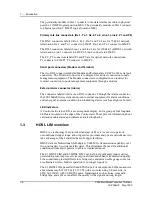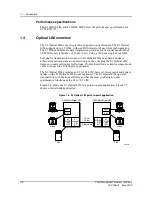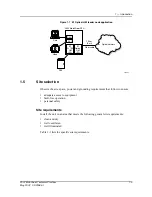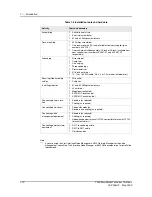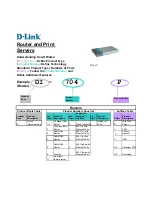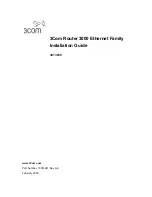
Contents
xiv
2902 MainStreet Technical Practices
90-2906-01 May
2002
17.9
Clocking (synchronous only) ........................................................................... 17-9
17.10
Multidrop data bridge .................................................................................... 17-12
17.11
Super-rate configuration for DNIC or 2B1Q modules ................................... 17-13
17.12
Loss-of-synchronization debounce time (DNIC only) ................................... 17-14
18 — RS-232 DCM
18-1
18.1
Understanding the RS-232 DCM .................................................................... 18-2
18.2
RS-232 DCM circuit operating parameters .................................................... 18-2
18.3 Device
mode
................................................................................................... 18-3
18.4 Device
gender
................................................................................................. 18-3
18.5 Full
duplex
...................................................................................................... 18-4
18.6 RTS/CTS
delay
............................................................................................... 18-4
18.7 Control
signals
................................................................................................ 18-5
18.8
Data structure (asynchronous only) ................................................................ 18-6
18.9
Clocking (synchronous only) ........................................................................... 18-7
18.10
Multidrop data bridge ...................................................................................... 18-9
19 — X.21 and V.35 DCMs
19-1
19.1
Understanding X.21 and V.35 DCMs .............................................................. 19-2
19.2
X.21 and V.35 circuit operating parameters ................................................... 19-2
19.3 Device
mode
................................................................................................... 19-4
19.4 Device
gender
................................................................................................. 19-4
19.5 Duplex
method
................................................................................................ 19-5
19.6 RTS/CTS
delay
............................................................................................... 19-6
19.7 Control
signals
................................................................................................ 19-7
19.8
Data structure (asynchronous only) ................................................................ 19-8
19.9
Clocking (synchronous only) ........................................................................... 19-9
19.10
Multidrop data bridge .................................................................................... 19-12
19.11
Super-rate configuration for the X.21 and V.35 DCMs ................................. 19-13
20 — Codirectional DCM
20-1
20.1
Understanding the Codirectional DCM ........................................................... 20-2
20.2
Codirectional DCM Module and circuit parameters ........................................ 20-2
20.3 Trunk
conditioning
.......................................................................................... 20-3
20.4 Alarm
times
..................................................................................................... 20-3
20.5
8 kHz timing ................................................................................................... 20-4
20.6
All Ones alarm indication signal ...................................................................... 20-4
21 — Transparent rate adaption
21-1
21.1 Rate
adaption
overview
.................................................................................. 21-2
21.2
Transparent rate adaption overview ............................................................... 21-2
21.3 Transport
bandwidth
....................................................................................... 21-3
21.4 Transport
position
........................................................................................... 21-5
22 — HCM rate adaption
22-1
22.1 Rate
adaption
overview
.................................................................................. 22-2
22.2
HCM rate adaption overview .......................................................................... 22-2
Summary of Contents for MainStreet 2902
Page 1: ...2902 MainStreet Network Termination Unit Release 1 0 H T E C H N I C A L P R A C T I C E S ...
Page 40: ...3 Mounting the unit 3 8 2902 MainStreet Technical Practices 90 2906 01 May 2002 ...
Page 50: ...4 Ground and power connections 4 10 2902 MainStreet Technical Practices 90 2906 01 May 2002 ...
Page 68: ...6 Connecting to the network 6 4 2902 MainStreet Technical Practices 90 2906 01 May 2002 ...
Page 90: ...7 Connecting to data devices 7 22 2902 MainStreet Technical Practices 90 2906 01 May 2002 ...
Page 108: ...10 Node management 10 10 2902 MainStreet Technical Practices 90 2906 01 May 2002 ...
Page 150: ...14 CPSS 14 6 2902 MainStreet Technical Practices 90 2906 01 May 2002 ...
Page 218: ...20 Codirectional DCM 20 6 2902 MainStreet Technical Practices 90 2906 01 May 2002 ...
Page 234: ...22 HCM rate adaption 22 10 2902 MainStreet Technical Practices 90 2906 01 May 2002 ...
Page 246: ...23 Cross connecting circuits 23 12 2902 MainStreet Technical Practices 90 2906 01 May 2002 ...
Page 254: ...24 Visual indicators 24 8 2902 MainStreet Technical Practices 90 2906 01 May 2002 ...
Page 266: ...25 Alarms 25 12 2902 MainStreet Technical Practices 90 2906 01 May 2002 ...
Page 278: ...26 System diagnostics 26 12 2902 MainStreet Technical Practices 90 2906 01 May 2002 ...
Page 298: ...27 Loopbacks 27 20 2902 MainStreet Technical Practices 90 2906 01 May 2002 ...
Page 332: ...Glossary GL 8 2902 MainStreet Technical Practices 90 2906 01 May 2002 ...
Page 343: ......
Page 344: ... 2002 Alcatel All rights reserved 90 2906 01 95 1820 01 00 C ...






















